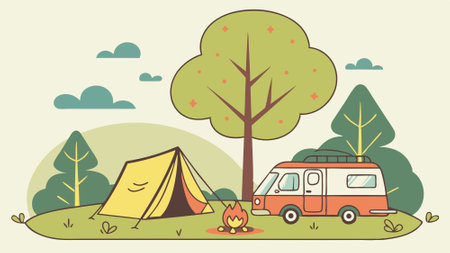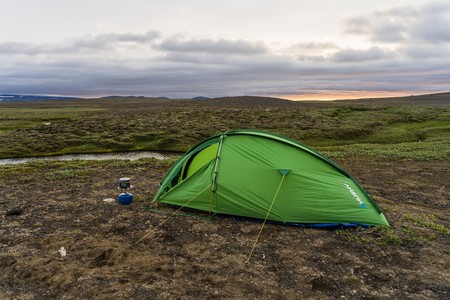1. What is Glamping?
Glamping, short for “glamorous camping,” is a modern twist on traditional camping that combines the beauty of nature with the comfort and luxury of high-end accommodations. Unlike classic camping, which often involves pitching a tent, sleeping on the ground, and cooking over a campfire, glamping offers cozy beds, climate control, private bathrooms, and even gourmet meals—all in the heart of the great outdoors.
In recent years, glamping has taken off across America as more people look for unique travel experiences that allow them to unwind in nature without giving up modern comforts. Whether it’s a safari tent in Montana or a treehouse in California, glamping lets travelers enjoy scenic landscapes while staying in stylish, well-equipped spaces.
How Glamping Differs from Traditional Camping
| Feature | Traditional Camping | Glamping |
|---|---|---|
| Accommodation | Tent or sleeping bag under the stars | Cabin, yurt, Airstream, or luxury tent |
| Bedding | Sleeping pad or air mattress | Real bed with linens and pillows |
| Amenities | Minimal—basic utilities or none at all | Electricity, Wi-Fi, heating/AC, private bath |
| Food | Campfire cooking or packed meals | Catered meals or on-site dining options |
| Setup Time | DIY setup required | No setup—everything ready upon arrival |
This elevated form of outdoor travel appeals to families, couples, and solo adventurers who want to connect with nature without compromising on comfort. As the popularity of glamping continues to grow in the U.S., more destinations are offering these upscale outdoor stays—making it easier than ever to escape the hustle and bustle while still enjoying a little luxury.
2. The Evolution of Camping in the U.S.
Camping has long been a beloved American pastime, but the way people experience the great outdoors has changed dramatically over the decades. From early rustic retreats to today’s luxury glamping resorts, camping in the U.S. has evolved with shifting travel trends and consumer preferences.
From Roughing It to Relaxing
In the early 1900s, camping was largely about survival skills and connecting with nature in its rawest form. Families would pack tents, cook over open fires, and sleep on the ground. It was simple, rugged, and often uncomfortable—but it was also an adventure.
As time went on, especially after World War II, road trips became more popular and accessible. The rise of national parks and roadside campgrounds made it easier for families to travel and camp together. This era saw the beginning of RV culture—bringing with it a new level of comfort and convenience to outdoor living.
The Shift Toward Comfort
By the 1980s and 1990s, consumer expectations had started to shift. People wanted to enjoy nature without giving up all their modern comforts. Campgrounds began adding amenities like electrical hookups, restrooms with showers, and even Wi-Fi access. These changes reflected a broader trend: Americans were no longer satisfied with just “roughing it.” They wanted experiences that combined adventure with ease.
The Birth of Glamping
This desire for comfort while staying close to nature laid the foundation for glamping—short for “glamorous camping.” Glamping offers unique accommodations such as safari tents, yurts, treehouses, and tiny homes—all fully equipped with beds, electricity, and sometimes even air conditioning or hot tubs.
Glamping started gaining traction in the early 2000s but really took off in the 2010s as social media showcased stunning photos of cozy tents under starry skies and luxury cabins nestled in scenic landscapes. Millennials in particular embraced this trend as they looked for Instagram-worthy travel experiences that didn’t compromise on comfort.
Traditional Camping vs Glamping
| Feature | Traditional Camping | Glamping |
|---|---|---|
| Accommodations | Tent or RV | Luxury tent, yurt, cabin |
| Amenities | Basic (fire pit, picnic table) | Electricity, bathrooms, heating/cooling |
| Bedding | Sleeping bag or air mattress | Real bed with linens |
| Cuisine | Campfire cooking | Private chef or gourmet meal kits |
| Experience Focus | Survival and simplicity | Comfort and aesthetics |
A Reflection of Changing Lifestyles
The rise of glamping mirrors broader lifestyle shifts in America. Today’s travelers are seeking meaningful experiences that combine relaxation with discovery. They want connection—to nature, to local culture, and to each other—without sacrificing comfort or style. Glamping delivers all that by merging outdoor beauty with boutique-level service.
The Future is Flexible
The evolution of camping continues as technology improves and preferences change. From eco-friendly domes to mobile glamp sites that follow seasonal weather patterns, Americans now have more ways than ever to explore nature on their own terms—with a touch of luxury along the way.

3. Types of Glamping Experiences
Glamping in America has taken off in a big way, offering travelers a wide range of unique and luxurious outdoor experiences. Whether youre looking to sleep under the stars or enjoy high-end amenities in the middle of nature, there’s a glamping option for everyone. Heres a look at some of the most popular types of glamping accommodations you can find across the U.S.
Safari Tents
Inspired by traditional African safari camps, these canvas tents offer a blend of rustic charm and modern comfort. Most come equipped with real beds, electricity, and even en-suite bathrooms. You’ll often find them in scenic locations like national parks or vineyards, making them perfect for those who want to experience nature without sacrificing comfort.
Yurts
Originally used by nomadic tribes in Central Asia, yurts have become a favorite among American glampers. These circular structures are typically insulated and furnished with cozy interiors that include beds, heating, and sometimes even kitchens. Yurts are especially popular in mountain and forest regions where they provide warmth and shelter year-round.
Airstreams
A classic American icon, Airstream trailers have been reimagined for the luxury camping scene. These retro campers offer stylish interiors complete with plush bedding, kitchenettes, and air conditioning. Many glamping resorts park Airstreams in scenic spots like deserts or coastlines, giving guests a nostalgic yet upscale getaway.
Treehouses
For those looking to relive their childhood dreams (but with a grown-up twist), treehouse glamping is a must-try. Built high above the ground, these structures often feature full bathrooms, balconies with stunning views, and even hot tubs. Treehouse stays are especially popular in wooded areas like the Pacific Northwest and Appalachian Mountains.
Comparison of Popular Glamping Options
| Type | Main Features | Best For | Popular Locations |
|---|---|---|---|
| Safari Tents | Canvas walls, real beds, private bathrooms | Luxury seekers who love open landscapes | California wine country, Utah deserts |
| Yurts | Circular design, insulated walls, cozy interiors | All-season adventurers | Colorado mountains, Oregon forests |
| Airstreams | Retro style, modern amenities inside | Nostalgic travelers who love road trips | Texas Hill Country, Arizona deserts |
| Treehouses | Elevated builds, panoramic views, luxury features | Romantic getaways or family fun | Tennessee woods, Washington state forests |
The Takeaway on Glamping Choices
No matter your travel style or comfort level with the outdoors, theres a glamping setup that fits your needs. From sleeping among treetops to cozying up in a stylish trailer under the stars, Americas diverse landscapes make it easy to enjoy nature without giving up the perks of luxury living.
4. Why Americans are Choosing Glamping
In recent years, glamping—short for “glamorous camping”—has become a booming trend across the United States. But why are so many Americans swapping traditional tents for luxury yurts, safari tents, and treehouses with hot tubs? The answer lies in a mix of cultural shifts, social trends, and economic factors that make glamping an attractive option for modern travelers.
Cultural Shift Toward Experiences
Many Americans today value experiences over material possessions. This shift has led to a rise in travel styles that offer more than just sightseeing. Glamping fits perfectly into this mindset—it provides a unique way to connect with nature without giving up comfort. People want to unplug from their busy lives but not sacrifice basic amenities like clean bathrooms, cozy beds, or even Wi-Fi.
The Influence of Wellness Tourism
The wellness movement has taken hold in the U.S., encouraging people to focus on mental and physical well-being. Glamping destinations often highlight activities like yoga classes, nature hikes, meditation sessions, and farm-to-table dining. These offerings attract travelers looking to relax and recharge without the stress of planning complicated trips.
Social Medias Role
Instagram and TikTok have turned glamping spots into must-visit destinations. With stunning backdrops—think mountains, forests, and lakes—these locations are perfect for snapping photos and sharing online. The aesthetics of glamping sites are designed to be “Instagrammable,” which draws in younger generations who want their vacations to look as good as they feel.
Economic Accessibility Compared to Luxury Travel
While luxury resorts can be expensive and far away, glamping offers a more budget-friendly alternative that still feels upscale. For families, couples, or solo travelers who want a special getaway without breaking the bank, glamping is a smart choice. Many sites offer tiered pricing based on amenities and seasonality.
Cost Comparison: Traditional Camping vs Glamping vs Hotels
| Accommodation Type | Average Cost Per Night | Main Features |
|---|---|---|
| Traditional Camping | $20 – $50 | Tent site only, bring your own gear |
| Glamping | $100 – $300 | Luxe tents/yurts, beds, electricity, private baths |
| Hotels/Resorts | $150 – $500+ | Amenities like pools, gyms, restaurants |
A Social Activity That Brings People Together
The rise of group travel—whether its family reunions or friend getaways—also plays a role. Glamping offers shared spaces like fire pits, outdoor kitchens, and communal lounges that encourage connection while still allowing for personal space. Its a balanced blend of socializing and solitude that appeals to many Americans today.
The Bottom Line: Nature with Comfort Wins
Cultural values are shifting toward mindful living and meaningful experiences. Add in the influence of social media and wellness trends, plus economic flexibility compared to traditional luxury travel—and its no surprise why glamping continues to gain popularity across the U.S.
5. Top Glamping Destinations in the U.S.
Glamping has taken off across the United States, offering travelers a unique way to enjoy the great outdoors without giving up modern comforts. Whether you’re looking for a mountain escape, desert adventure, or oceanfront stay, there’s a luxurious glamping spot waiting for you. Here are some of the top destinations where nature and comfort go hand in hand.
Yellowstone Under Canvas – Montana
Located just minutes from Yellowstone National Park, this site offers safari-inspired tents with wood-burning stoves and king-size beds. Guests can explore the park during the day and return to luxury accommodations at night.
AutoCamp Yosemite – California
This stylish glamping resort near Yosemite National Park features custom-designed Airstreams, luxury tents, and cabin suites. The on-site clubhouse includes a fire pit lounge and curated local snacks.
The Resort at Paws Up – Montana
A pioneer in American glamping, Paws Up blends wilderness with high-end service. Stay in safari-style tents complete with en-suite bathrooms and personal butlers while enjoying activities like horseback riding and fly-fishing.
Dunton River Camp – Colorado
Set on a former cattle ranch, this riverside retreat offers canvas tents with soaking tubs, heated floors, and gourmet meals. It’s ideal for couples looking for both privacy and adventure in the San Juan Mountains.
Zion Glamping Adventures – Utah
Just outside Zion National Park, this destination offers domes and bell tents under star-filled skies. Guests can enjoy nearby hikes and then unwind by the campfire or in a hot tub with canyon views.
Comparison of Top Glamping Destinations
| Destination | Location | Accommodation Type | Nearby Attraction |
|---|---|---|---|
| Yellowstone Under Canvas | Montana | Safari Tents | Yellowstone National Park |
| AutoCamp Yosemite | California | Airstreams & Luxury Tents | Yosemite National Park |
| The Resort at Paws Up | Montana | Luxury Safari Tents | Private Ranch Activities |
| Dunton River Camp | Colorado | Canvas Tents | San Juan Mountains |
| Zion Glamping Adventures | Utah | Domes & Bell Tents | Zion National Park |
No matter your style—rustic chic, eco-friendly, or full-on luxury—there’s a glamping destination in the U.S. that fits the bill. These spots offer unforgettable outdoor experiences without sacrificing comfort, making them perfect for weekend getaways or longer nature retreats.
6. The Future of Glamping in America
Glamping in the U.S. has gone from a niche experience to a booming travel trend, and it’s not slowing down anytime soon. As more people seek unique, comfortable ways to connect with nature, the industry is evolving quickly. Let’s take a look at what’s next for glamping in America, focusing on sustainability, technology, and consumer preferences.
Sustainability Is Taking Center Stage
Eco-friendly practices are becoming a major focus for glamping operators. Guests increasingly want their stays to reflect their values—especially when it comes to protecting the environment. From solar-powered tents to composting toilets and locally sourced materials, here are some sustainable features that are shaping future glamping sites:
| Sustainable Feature | Description |
|---|---|
| Solar Energy | Tents and cabins powered by solar panels instead of traditional electricity sources. |
| Eco-Friendly Toilets | Composting or water-saving toilets reduce environmental impact. |
| Recycled Materials | Campsites built with reclaimed wood, recycled metal, or other repurposed materials. |
| Local Sourcing | Using local food, labor, and resources to support surrounding communities. |
| Minimal Land Impact | Tent platforms and structures designed to leave little-to-no trace on the land. |
The Role of Technology in Glamping
You might think technology doesn’t belong in nature—but for many travelers, it enhances the experience. Glamping sites are now integrating smart features that offer both convenience and comfort without taking away from the outdoor vibe.
Popular Tech Integrations in Glamping Sites:
- Smart Lighting: Motion-activated or app-controlled lights that reduce energy use.
- Wi-Fi Connectivity: High-speed internet access for remote workers or social media sharing.
- Mobile Check-In: Contactless check-in through apps for added convenience.
- Solar Charging Stations: Power up phones and devices sustainably right at your campsite.
- Climate Control: Smart thermostats or heated floors inside luxury tents or domes.
The Growing Demand from Diverse Travelers
The future of glamping also depends on who is choosing these experiences—and the demand is coming from all directions. Families, solo travelers, couples, digital nomads, and even retirees are looking for ways to enjoy nature without giving up comfort. This broad appeal is pushing glamping businesses to diversify their offerings even more.
Diverse Traveler Needs & How Glamping Meets Them:
| User Group | Main Needs | How Glamping Delivers |
|---|---|---|
| Families with Kids | Safety, space, activities | Larger tents/cabins with kid-friendly amenities and on-site activities like hiking or canoeing |
| Couples | Privacy, romance | Tucked-away locations with hot tubs, private decks, or fire pits under the stars |
| Remote Workers/Nomads | Connectivity, comfort | A reliable Wi-Fi connection and quiet spaces to work surrounded by nature |
| Seniors/Retirees | No roughing it, easy access | No-stairs accommodations, soft bedding, heating/AC systems for year-round stays |
| Solo Travelers | A sense of adventure + safety | Campsites near small towns or guided experiences for peace of mind and exploration opportunities |
A Bright Path Ahead for Glamping in America
The American glamping scene is transforming fast—with innovation focused on being greener, smarter, and more inclusive than ever before. Whether its through luxurious treehouses equipped with Wi-Fi or eco-domes powered entirely by solar energy, one thing is clear: people want meaningful outdoor escapes that don’t compromise on comfort. The future of glamping looks promising as it adapts to meet the changing needs of modern adventurers.


